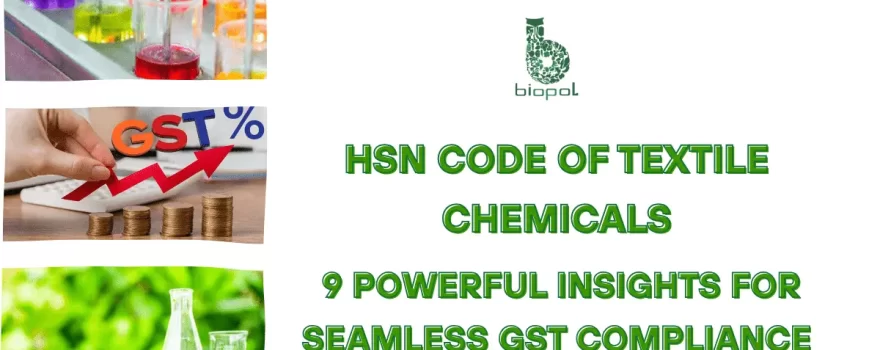
Understanding the HSN Code of Textile Chemicals is essential for any business involved in textile processing, manufacturing, or trading. Whether you’re dealing with dyes, auxiliaries, surfactants, or finishing agents, the correct HSN classification ensures compliance with GST regulations, smooth invoicing, and hassle-free import-export procedures. This guide covers everything you need to know about the HSN Code of Textile Chemicals—from GST rates and product categories to invoicing accuracy and trade documentation—so you can avoid penalties, claim input tax credits, and operate with full regulatory clarity.
Table of Contents
The Harmonized System of Nomenclature (HSN) code is an internationally accepted classification framework utilized to classify products, such as textile chemicals, for purposes of taxation, invoicing, and adherence to trade regulations under the Goods and Services Tax (GST).
Key Points:
- Structure: 8-digit code under Indian GST.
- Purpose: Identifies chemical types (e.g., dyes, auxiliaries) for correct tax rates.
- Who Needs It: Essential for textile manufacturers, processors, suppliers, and exporters.
- Typical Chapters: 28 (Inorganic), 29 (Organic), and 38 (Miscellaneous chemical products).
HSN Code of Textile Chemicals in India
In India, most textile chemicals are classified under Chapter 38 of the Customs Tariff Act.
| Product Type | HSN Code | GST Rate |
| Textile auxiliaries | 3809 | 18% |
| Finishing agents | 3809.91 | 18% |
| Dyeing and printing preparations | 3809.92 | 18% |
Correct application of the HSN Code of Textile Chemicals ensures GST compliance, invoicing accuracy, and audit readiness.
Textile Chemical Categories & HSN Codes
| Category | HSN Code(s) |
| Dyeing & Printing Chemicals | 3204, 3206, 3210 |
| Finishing Chemicals | 3809, 3812 |
| Auxiliary Chemicals | 3402, 3824 |
| Sizing & Coating Agents | 3809, 3909 |
| Anti-microbial Chemicals | 3809 |
| Bleaching Agents | 2841 |
| Water & Oil Repellents | 3809 |
| Cleaning & Scouring Agents | 3402 |
GST Rates for Common Textile Chemicals
Here are standard GST rates associated with common HSN Codes for textile chemicals. For a more detailed breakdown of applicable tax percentages for textile chemicals in India, including exemptions and rate updates, read this guide.
| HSN Code | Category | GST Rate |
| 3204 | Dyes and pigments | 18% |
| 3206 | Other coloring matter | 18% |
| 3210 | Printing pastes | 18% |
| 3809 | Textile preparations & auxiliaries | 18% |
| 3812 | Stabilizers, flame retardants | 18% |
| 3402 | Surfactants, emulsifiers | 18% |
| 3824 | Other chemical preparations | 18% |
| 3909 | Coating and laminating materials | 18% |
| 2841 | Bleaching agents | 18% |
Invoicing Accuracy & Compliance
Correct HSN coding ensures:
- Proper GST calculation
- Eligible input tax credits (ITC)
- E-invoicing and return filing compliance
- Accurate reporting and documentation
Risks of Incorrect HSN Code Usage
Misclassification can result in:
- GST issues: Wrong tax rates or ITC denial
- Penalties: Up to ₹10,000 or 100% of tax (whichever is higher) under Section 122 of CGST Act
- Operational delays: Customs clearance or audit scrutiny
- Reputational damage: With clients, suppliers, and authorities
How to Avoid Errors:
- Train staff regularly
- Use GST classification tools (CBIC, GSTN Portal)
- Consult tax professionals
HSN Code for Import/Export
Correct HSN classification is critical for international trade:
- Ensures customs clearance
- Determines correct customs duties and IGST rates
- Required for export incentives and zero-rated supplies
| HSN Code | Use Case |
| 3204 | Dyes and pigments for export |
| 3206 | Other coloring matter |
| 3210 | Printing pastes |
| 3809 | Textile auxiliaries (softeners, agents) |
| 3812 | Flame retardants |
| 3402 | Surfactants for scouring and washing |
| 3824 | General textile chemical preparations |
| 3909 | Laminating agents |
Required Documents:
- Export Invoice
- Packing List
- Bill of Lading (Export)
- Bill of Entry & Import Invoice (Import)
GST Compliance for Trade:
- IGST applicable on imports based on HSN
- Exports generally zero-rated but need proper HSN for ITC refund
How to Find the Right HSN Code
To ensure you’re using the correct HSN Code of Textile Chemicals, follow these steps:
- Use Official Tools: CBIC HSN Search, GSTN Portal
- Product Review: Match chemical function with official classification
- Online Classifiers: Use HSN finder tools
- Get Expert Help: Consult a GST professional or chartered accountant
Final Thoughts
Using the correct HSN Code of Textile Chemicals is vital for:
- GST compliance
- Accurate invoicing
- Smooth import/export
- Avoiding legal penalties
Invest in classification tools and expert advice to ensure compliance and safeguard your operations.
Frequently Asked Questions
What is the HSN code 29153990?
HSN Code 29153990 falls under Chapter 29 (Organic Chemicals) and typically covers other esters and their derivatives not specifically mentioned elsewhere. It may be used for specialty chemicals, including certain textile auxiliaries, depending on composition. Classification should be confirmed based on the exact chemical formulation.
What is the HSN code 42031010?
HSN Code 42031010 belongs to Chapter 42 (Articles of leather; saddlery and harness), specifically for belts and bandoliers made of leather used with clothing. This code is unrelated to textile chemicals and is instead used in the apparel and leather accessories category.
What is the HSN code for textile chemicals?
Textile chemicals are broadly classified under HSN Code 3809, which includes chemical preparations used in textile, paper, and leather industries. Specific codes may vary based on the chemical type, such as dyes (3204), surfactants (3402), or finishing agents (3809.91).

